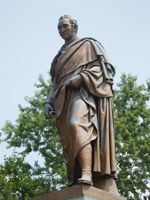About
By the mid-1800s, with monumental public art becoming fashionable, the Missouri State Legislature passed a bill to provide $2,500 to commemorate Thomas Hart Benton, one of the State’s best known politicians. The task of determining the type of monument for this first work of public art in St. Louis was assigned to a committee composed of local businessmen, including Wayman Crow.
Twenty-year-old Harriet Hosmer, born in Watertown, Massachusetts, wanted to be a sculptor, which required the study of anatomy, a subject limited to male students through medical schools. She came to St. Louis where her school friend Cornelia Crow’s father arranged for private anatomy lessons at McDowell’s Medical College. Crow recommended Hosmer to the committee for the Benton sculpture. The members accepted her proposal for a bronze portrait in the neoclassical style, which used Benton’s image as inspiration rather than as a true likeness. The legislature, surprisingly, accepted both the unusual style for the statue and the woman artist.
The legislature’s allocation was not enough to complete the project, so Crow initiated a private fundraising effort, which resulted in an additional $33,500 to supplement the state’s $2,500. Hosmer prepared a model in Rome, which was then cast at the Royal Foundry in Munich (owned by the family of Ferdinand von Miller II, sculptor of several works in Tower Grove Park).
The May 27, 1868, unveiling of St. Louis’ first public art was cause for schools and businesses to close; forty thousand people attended the event, which included the firing of 30 canons, one for each year of Benton’s service as senator.
Dimensions: 10′ x 4′ x 4′
Year Completed: 1864
Material: Bronze with granite pedestal
Owner: City of St. Louis
Donor: Missouri State Legislature and private donors
